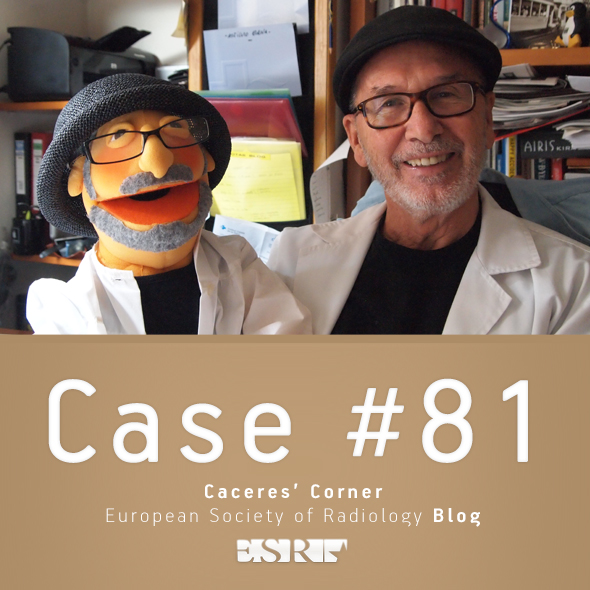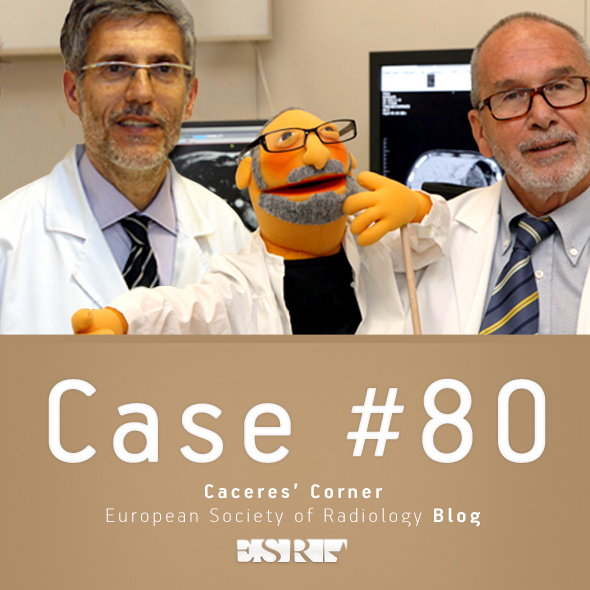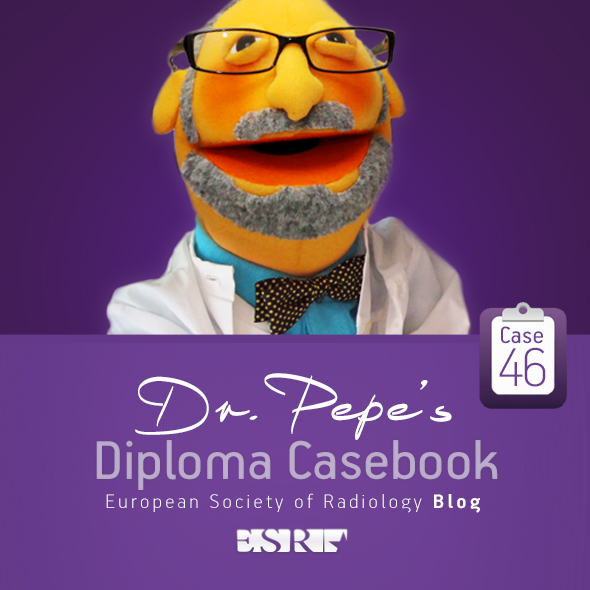
Dear Friends,
Muppet and I just returned from the RSNA meeting in Chicago (Muppet very happy after spending the week with Miss Piggy!). This week we’re presenting a straightforward case to make you happy as well. Images belong to a 63-year-old man with vague chest complaints.
Where is the abnormality and what do you think it is? Leave yout thoughts and diagnosis in the comments section and come back on Friday for the answer.
Read more…

A-451 Coronary artery imaging from a chest CT examination: when and how
R. Marano | Sunday, March 10, 14:00 – 15:30 / Room G/H
The continuous technological evolution of multi-detector CT scanner characterized by larger detector array with increased anatomical coverage per rotation, faster rotation and table speed, and shorter acquisition time have made reliable to perform chest imaging with reduced cardiac motion artifacts, improving the assessment of heart and contiguous structures in the course of routine thorax CT. Further, the larger anatomic coverage of detectors and the availability of scan protocols with lower radiation dose have also made reliable to apply ECG-synchronization to chest CT study, and therefore to couple cardiac/coronary imaging with chest imaging. Different clinical queries requiring a chest CT imaging may underlie cardiac or coronary source that is not clinically evident; similarly, patients scheduled for thoracic surgery, staging or studied in emergency setting may present unexpected heart or coronary artery findings that can be detected in the course of pre-operative CT or may change the treatment and prognosis. Therefore, the capability to perform the assessment of both the heart and chest by a single diagnostic tool is becoming progressively significant because the evaluation of the heart often can provide clinically relevant information in the course of routine or emergency chest CT that is not otherwise easily available.

A-549 A. Head and neck cancer
L. Oleaga Zufiría | Monday, March 11, 08:30 – 10:00 / Room E2
Identification of recurrent tumour in the post-therapy setting is often challenging. It is essential to have a baseline study for monitoring changes and evaluating possible recurrences. After surgery, there is distortion of the anatomy, the fat planes are lost, functional lymphadenectomy may be associated with muscle resection, resection of the jugular vein or grafting, therefore, it is essential to know this data to properly analyze the images. The immediate postoperative baseline study after surgery should be performed between 4 and 6 weeks after surgery. When radiotherapy is performed, there is loss of fat planes, significant edema in the mucosa and in subcutaneous tissue. The recommended baseline study should be obtained at 3 months after a completion of radiation therapy. The imaging methods used for the staging and follow-up of head and neck tumours varies between centres. CT is the most commonly used imaging technique, however, at some institutions MRI or PET are used to detect tumour recurrence after therapy, either surgery or chemo/radiation. Distinction between post-treatment changes and recurrent or residual tumor might be difficult to assess on imaging. A soft tissue mass present in the baseline study that decreases in size, should be considered treatment-related changes. If the mass increases in size, it is suggestive of persistent or recurrent tumor. A new onset mass in the follow-up study should be considered as recurrence. Late complications due to chemo/radiation include soft-tissue necrosis, osteochondronecrosis, carotid atherosclerosis, myelopathy, nerve paralysis secondary to fibrosis and sarcomas.

Dear Friends,
Today I’m showing a vintage case, seen thirty years ago when I was a promising young staffer. The images below belong to a 57-year-old missionary living in Africa and undergoing yearly controls at our institution for unilateral hyperlucent lung.
Leave me your thoughts and diagnosis in the comments section and come back on Friday for the solution.
Diagnosis:
1. Swyer-James/Macleod syndrome
2. Bronchial tumour
3. Pulmonary artery stenosis
4. None of the above
Read more…

B-0105 The incidence of biological effects from 3.0 Tesla (T) MRI compared to 1.5 T: an observational study in 911 consecutive outpatients
F. Alghamdi, P. Bertrand, L. Barantin, M.A. Lauvin, X. Cazals, F. Domengie, R. Bibi, D. Herbreteau, J.-P. Cottier | Thursday, March 7, 10:30 – 12:00 / Room L/M
Purpose: To compare the acute biological effects of a 3.0 Tesla (T) magnetic resonance imaging (MRI) to 1.5 T MRI
Methods and Materials: After MRI examination, 911 patients (449 with 3.0 T MRI and 462 with 1.5 T MRI) were presented with a verbal rating scale questionnaire consisting of 11 symptoms related to MRI examination. Chi-square tests were used to assess the relationship between the strength of the magnetic field (MF) and the incidence of the symptoms. A P value of <.05 was considered significant.
Results: There was no statistically significant relationship between the strength of the MF and the incidence of the symptoms related to static MF exposure, such as vertigo (P = .13), nausea (P = .35), headache (P = .21), and a metallic taste (P = .64). A warm feeling induced by radiofrequency (RF) was significantly higher in the 3.0 T MRI (P <.0001) with a significant correlation between the mean specific energy absorption rate (SAR) and a warm feeling in the 3.0 T MRI (P <.0001). Numbness/tingling related to the gradient MF was significantly higher in the 3.0 T MRI (P = .027).
Conclusion: The thermal effect induced by the RF and the numbness/tingling induced by the gradient field were significantly higher in the 3.0 T MRI than in the 1.5 T MRI. There was no statistically significant difference between the symptoms related to static MF exposure from the 3.0 T MRI and 1.5 T MRI.

Dear Friends,
This week I am showing you a case provided by my good friend Dr. Jordi Andreu. The radiographs below belong to a 39-year-old woman with increased shortness of breath for the last three months. Leave your thoughts and diagnosis in the comments section and come back for the answer on Friday.
Diagnosis:
1. Bullous emphysema
2. Tension pneumothorax
3. Adenomatoid malformation
4. None of the above
Read more…

B-0721 CT imaging in an emergency setting is not substantially delayed by iterative reconstruction
M.J. Willemink, A.M.R. Schilham, T. Leiner, W.P.T.M. Mali, P.A. de Jong, R.P.J. Budde | Sunday, March 10, 10:30 – 12:00 / Room N/O
Purpose: Iterative reconstruction (IR) is a promising noise reducing technique with the potential to reduce radiation-dose with preserved study interpretability or improve image-quality at similar radiation-dose. One of the major drawbacks of IR is a longer reconstruction time which may be problematic in the emergency setting. The purpose of the current study was to compare reconstruction time and speed of IR and filtered back-projection (FBP) in two commonly encountered emergency imaging scan-protocols: total body trauma CT and pulmonary CTA.
Methods and Materials: Fifteen patients underwent a total body CT after a traumatic event and twenty-five adults underwent a CTA for evaluation of pulmonary embolisms on a 256-slice CT-scanner. All data were reconstructed using FBP and two IR-levels (iDose4, Philips Healthcare). Quantification of reconstruction time and speed was done with a self-written plug-in for ImageJ (US National Institutes of Health).
Results: The mean delay in reconstruction time on total body trauma CTs was 44.4±8.1 and 44.9±7.0 seconds for iDose4-levels 1 and 6, respectively, and on pulmonary CTAs 10.1±9.6 and 12.0±11.8 seconds for iDose4-levels 2 and 4, respectively. The mean reconstruction time and speed for total body trauma CTs were 87.3±14.6, 131.7±16.7 and 132.2±17.9 seconds, and 20.1±1.6, 13.2±0.8 and 13.2±0.6 slices/s for FBP, iDose4-levels 1 and 6, respectively, and for pulmonary CTAs 25.5±7.0, 35.6±9.0 and 37.6±12.0 seconds, and 26.7±5.6, 18.7±2.3 and 18.0±2.8 slices/s for FBP, iDose4-levels 2 and 4, respectively.
Conclusion: CT image reconstruction in an emergency setting is not delayed substantially by IR. Furthermore, reconstruction time and speed did not differ substantially between different IR-levels.

MS 4 – Hepatocellular carcinoma
B. Sangro, A. Benito, J.I. Bilbao, F. Pardo | Friday, March 8, 08:30 – 10:00 / Room F1
A-075 Chairman’s introduction
A variety of options are available for the treatment of hepatocellular carcinoma (HCC) from liver transplantation or resection to percutaneous ablation by chemical or physical procedures, intraarterial injection of embolizing particles that may also serve as carriers of chemotherapeutic agents or radiation-emitting isotopes, or systemic delivery of molecularly targeted agents. Although large scale studies have identified groups of patients that may certainly benefit from some of these therapeutic tools, many areas of uncertainty still exist. Only by the coordinated action of HPB Oncology multidisciplinary teams may patients with HCC receive the best possible treatment.
Read more…

Dear Friends,
Today I am presenting the case of a 52-year-old man who underwent a bilateral lung transplant two years ago. He developed chest pain following bronchoscopy and endobronchial biopsy.
Examine the images below and leave your thoughts in the comments section.
What do you see?
It is significant?
Read more…

B-0949 MRI-based selection of clinical complete and good responders after chemoradiation for rectal cancer allows for successful minimal invasive treatment
L. Heijnen, M. Maas, M.H. Martens, D.M.J. Lambregts, J.W.A. Leijtens, R.G.H. Beets-Tan, G.L. Beets | Monday, March 11, 14:00 – 15:30 / Room E2
Purpose: Patients with good or complete response after neoadjuvant chemoradiation have excellent long-term outcome. Minimal invasive treatment (i.e. transanal endoscopic microsurgery (TEM) and wait-and-see policy) are increasingly considered as an alternative to major surgery. With this prospective cohort study we aimed to evaluate long-term outcome of strictly MR-based selected patients who have been treated with minimal invasive treatment.
Methods and Materials: Eight weeks after chemoradiation, endoscopy and restaging MRI were performed (including diffusion-weighted MRI for yT-staging and gadofosveset-enhanced MRI for yN-staging). Complete responders were selected for wait-and-see policy and good responders with small tumour remnant for TEM. Both treatment groups underwent intensive 3-to-6 monthly follow-up, using MR imaging (DWI+gadofosveset), CEA, CT of thorax and abdomen and endoscopy was performed. Long-term outcome was estimated with Kaplan-Meier curves.
Results: Forty-one patients were included, thirty-three in the wait-and-see group and eight in the TEM-group. Mean follow-up was 26 months (range 6-91). For the TEM-group, 4 patients had ypT0 and 4 had ypT2. Two patients, both in the wait-and-see group, developed a local recurrence within two years and underwent surgery, leading to a 2-year local recurrence rate of 9 %. Both recurrences were detected on (DWI-)MRI in an early stage. The cumulative probabilities of 2-year disease-free survival and overall survival were 93 % and 100 %, respectively. No recurrences occurred in the TEM-group.
Conclusion: Both selection and follow-up of good and complete responders after chemoradiation for rectal cancer with MRI is feasible. Long-term outcome so far is excellent. (DWI-)MRI seems to be a reliable tool for early recurrence detection.









